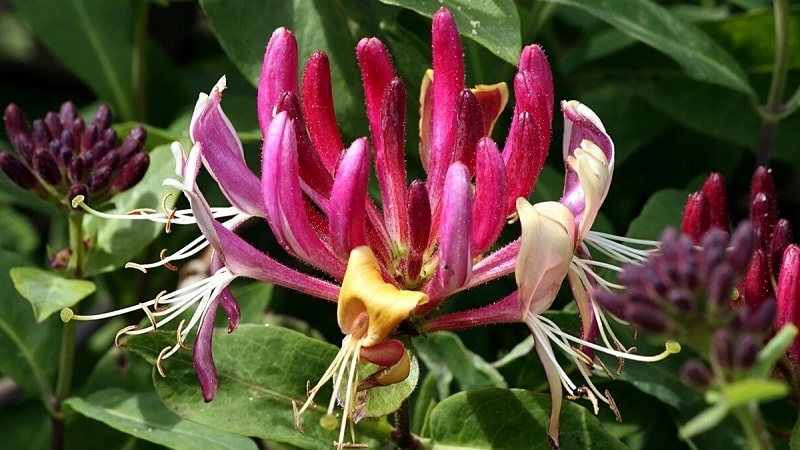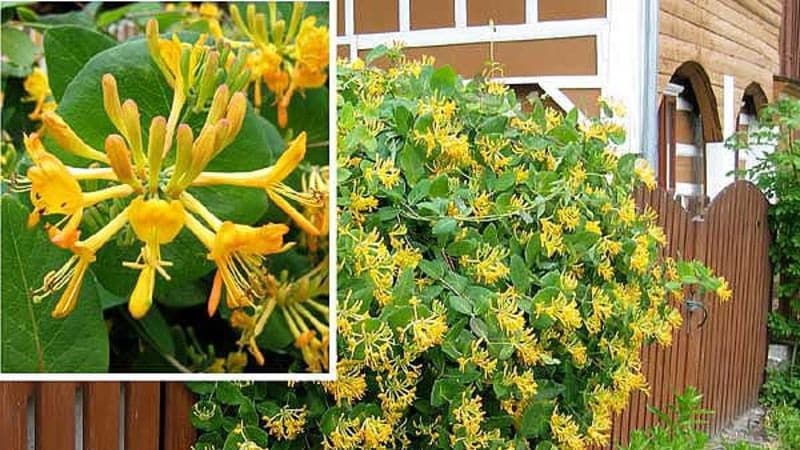Decorative honeysuckle variety "Caprifol"
When laying out a garden, they try to select plants so that they harmoniously combine with each other, the flowering of one gives way to another. There are plants that look good in any garden and are undemanding in terms of where they are grown. One of these plants is the decorative honeysuckle honeysuckle.
Description of honeysuckle honeysuckle
There are more than 200 species in the honeysuckle genus. Among them there are trees, shrubs and vines. Species with edible berries are grown in orchards for harvest. Among decorative types of honeysuckle, shrubby forms and vines are very popular among landscape designers.
Origin, development and history of breeding
Honeysuckle honeysuckle (Lonícera caprifólium) is a beautiful vine of climbing varieties.. In the reference literature there are other names for it - goat honeysuckle and fragrant honeysuckle. The species name “honeysop” is translated from Latin as “goat leaf”. In the wild, the plant grows on sunny edges and in the forests of the Caucasus and southern Europe.

Honeysuckle was first noticed by botanist breeders in Germany in the 18th century., and later in North America. This is how varieties were bred that had increased frost resistance and a different color of flowers and leaves. In Russia, the liana became widespread in the 19th century, when the fashion for a romantic style of gardens appeared - statues and gazebos entwined with lianas.
Characteristics, description of appearance
Honeysuckle Honeysuckle is a perennial vine with woody shoots, growing up to 5 m in height. The plant needs support, attaching itself to it with leaf petioles.
The leaves of the species are simple, entire, round, from 4-6 cm in diameter, sessile opposite. The leaf blade is green and shiny above, and has a gray-blue tint below. The upper 3-4 pairs of leaves grow together at their bases and form an elliptical disk. Bell-shaped flowers are located whorled in the axils of the leaves, 3-5 pieces each. The fruits are bright orange juicy berries 1 cm in size - arranged in 2 pieces. or grow together.
Honeysuckle honeysuckle has many interesting varieties:
- Honeysuckle Inga - a liana up to 8 m, distinguished by yellowish-pink flowers with a strong honey aroma.
- Harlequin – variegated form of honeysuckle. The green leaves have a white edge along the edges, and mauve flowers bloom against them. The liana grows up to 3.5 m and prefers sunny areas.
- Belgica Select - a plant with large leaves and purple flowers. The flowering period occurs in May.
- Graham Thomas. The length of the vine is up to 5 m. The variety is interesting for its delicate flowers of creamy white color and a different flowering time - from mid-July to September.
- Goldflame - bicolor honeysuckle. The flowers are pink-red on the outside and light yellow on the inside.
- Dropmore Scarlet - a variety with orange-fiery flowers against a background of bright green foliage.
Features of application
Honeysuckle honeysuckle fruits are poisonous and should not be eaten.. This liana is decorative and is used to decorate gardens and parks.

Landscape designers have the beautiful honeysuckle on their list of undemanding plants to grow and particularly ornamental plants for vertical gardening. She does not grow without support, so they decorate with it:
- gazebos, arches, pergolas, trellises;
- unsightly outbuildings;
- chain-link fences;
- external walls of houses and terraces.
If honeysuckle is grown without support, it will become a ground cover plant.. It goes perfectly with conifers, deutzia, mock orange, hydrangea, weigela, and roses.
Description and flowering period
The liana blooms in early June. Against a background of bluish-green leaves, numerous large flowers (4-6 cm in length) bloom in cream, white, pink or red, depending on the variety. The flowers emit a delicate aroma, which manifests itself especially in the evening hours. The plant blooms continuously for a month: withered flowers dry out and are replaced by new buds.
Resistance to diseases and pests
Decorative honeysuckle rarely gets sick. In damp summers, it is susceptible to powdery mildew, ramularia (brown leaf spot) and tubercular disease. Aphids are considered the most dangerous pest for plants.

Resistance to cold and drought
In the first two years after planting, honeysuckle is covered with thin non-woven material in all regionsexcept the south. Honeysuckle is very moisture-loving, therefore, when choosing a place for it, they give preference to sunny areas with well-moistened soil. In the sun, the soil dries out faster, so more frequent watering is required. If this is not possible, the plant is planted in partial shade.
Attention! Despite the fact that honeysuckle loves moist soil, it should not be planted in areas with close groundwater. In such places, the contact of the roots with water will be constant, which will deprive them of normal air exchange and cause rotting.
Growing regions and climate requirements
All regions except the northern regions of Russia are suitable for growing honeysuckle.. A sharply continental climate prevails here, with long, little snow and frosty winters and short, cold summers. Varietal varieties of the crop grow slowly in such conditions and freeze slightly in winter.
Reference. Do not be afraid of the low frost resistance of the crop. If you have heat-loving plants such as roses and rhododendrons growing in your garden, preparing honeysuckle for winter will not be difficult.
Advantages and disadvantages
The beautifully flowering liana has deservedly gained popularity among gardeners and landscape designers due to the fact that:
 has a high decorative value throughout the season;
has a high decorative value throughout the season;- blooms magnificently and for a long time with fragrant flowers of various colors;
- decorates vertical surfaces of the garden;
- can be used as a screen for places that need to be hidden (outdoor bathroom, utility room);
- grows quickly;
- easy to care for.
No significant deficiencies were identified in the plant. Some gardeners complain about honeysuckle's ability to grow vigorously. Active growth of the crop is restrained by regular pruning and removal of excess lateral branches at the base.
Difference from other species and varieties
Honeysuckle honeysuckle is easily recognized by its characteristic upper leaves, fused into a ring, and bright orange berries.
Agricultural technology
In the first two years of life the plant needs special attention, but then it doesn’t take much time to care for.
Choosing a place in the garden and preparing holes
Choose a place to land:
- protected from draft winds;
- sunny or partial shade;
- at a distance of 60-100 cm from other perennials;
- with sufficient moisture.

Holes for seedlings are dug several days before planting. and pour plenty of water on it.
Reference. If you plan to plant a crop along a long pergola or fence, it is more convenient to dig a trench.
Preparing seedlings for planting
When purchasing honeysuckle seedlings, choose healthy two-year-old plants with a closed root system and 30-40 cm high. Before planting, the vine is watered and carefully shaken out of the pot. The roots are slightly straightened using a garden ripper or an old fork.
Soil requirements
The soil for planting the crop is chosen with a neutral or slightly acidic reaction environment (pH 5-6.5). The higher the fertility of the land, the better. On soils rich in organic matter, honeysuckle develops faster and blooms more abundantly. If the soil on the site does not correspond to the preferences of the plant, it is brought to the desired composition:
- on clay and loamy soils, improve aeration by adding sand and peat as loosening agents;
- poor soils are improved with humus (4-5 kg per 1 sq. m);
- acidic soil is limed with lime or dolomite flour (from 4-6 kg per 1 sq. m).
Dates, scheme and rules of planting
Planting of vines begins in the spring, when the threat of return frosts has subsided - after May 10. In one place, honeysuckle grows without replanting for 15-20 years, so it is not planted tightly:
- the distance between plants in a row is 1.5-2 m;
- keep 1.5-2 m to buildings and other perennials;
- when planting a large curtain or hedge in several rows, the row spacing is 2 m;
- the volume of the landing pit is 0.5 m³.
The technology for planting honeysuckle honeysuckle comes down to the following activities::
- Drainage (expanded clay, gravel or brick chips) is poured into pre-watered planting areas.
- Rotted manure and “Nitroammofoska” (20-30 g per 1 sq. m) are added to the fertile soil.
- Fill the soil to a third of the depth of the hole and place the seedlings, straightening their roots.
- Cover the top with the same soil and lightly compact the soil at the root collar.
- Tie the honeysuckle to a support.
- Water and mulch with humus.

Features of cultivation
Further care comes down to regular watering and systematic feeding., pruning excess branches and weed control, pests and diseases.
Each crop, even one that does not require special care, has nuances in cultivation that are useful for a beginner to know about. Let's reveal some secrets of honeysuckle agricultural technology:
- Weeding. Honeysuckle does not like unnecessary proximity, especially when it is weeds. Regular weeding is necessary, especially while the plants have not gained strength.
- Feeding. Three weeks after planting, the first fertilizing is carried out with complex fertilizer “Lux” (1 tbsp per 10 liters of water). Subsequent mineral fertilizing alternates with organic fertilizing (liquid mullein solution) and is carried out every 10-12 days. To strengthen the vine's immunity to winter, in late August - early September the plant is fed with phosphorus-potassium fertilizer (for example, 3 tablespoons of superphosphate and 1 tablespoon of potassium salt per 10 liters of water).
- Trimming. In the spring, sanitary cutting of dry, diseased and frost-damaged branches is carried out. In young seedlings, at a height of 40 cm, pinch the growth point for better branching. During the summer, faded inflorescences and heavily grown lashes are pruned from the vine. In the fall, sanitary pruning is carried out again.
Disease and pest control
It is easier to prevent any disease through prevention. In wet weather, plantings are watered against fungal diseases with Fitosporin-M (1-2 g per 5 liters of water). The systemic fungicide “Skor” (5 ml per 10 liters of water) will help cure diseased plants.For a complex of pests, proven chemicals are used: “Aktellik”, “Aktara” or “Inta-Vir”.
Interesting things on the site:
Preparing for winter
In late autumn, when the main leaves have flown off, the last sanitary pruning. The soil under the plants is mulched with a 15 cm layer of peat. In the first two years, the vines are removed from the supports and covered with one layer of thin white spunbond. They also cover young, just planted, honeysuckle.

Reproduction
The easiest way to propagate honeysuckle is vegetatively.:
- By layering. Two-year-old shoots are tilted to the ground and pinned with a staple at the point of contact with the ground. There, a shallow cut is made on the stem for better rooting. An earthen mound 10-12 cm high is poured over the pressed branch.
- Cuttings. Annual non-lignified branches are cut into 12-15 cm pieces and rooted in a damp mixture of peat and sand.
Difficulties in growing
Caring for this crop does not cause any particular difficulties for gardeners. Varietal and hybrid forms of honeysuckle honeysuckle are less frost-resistant and demanding level of soil fertility and light levels. Planted in the shade, they produce few flowers but remain attractive.
Conclusion
Fragrant blooming honeysuckle will decorate any garden in a landscape and romantic style. The crop does not require careful care and will forgive the gardener for missing a haircut or fertilizing. The main secret to success is to plant honeysuckle in the sun and do not forget to water it.